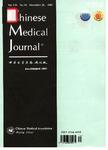High level expression of human Factor Ⅷ in mammalian cells after retroviral-mediated gene transfer
逆转录病毒载体介导人凝血因子Ⅷ在哺乳细胞中的高效表达(英文)作者机构:上海瑞金医院上海200025 中国科学研究所上海200031
出 版 物:《Chinese Medical Journal》 (中华医学杂志(英文版))
年 卷 期:2001年第114卷第7期
页 面:18-21,102-103页
核心收录:
学科分类:1002[医学-临床医学] 100201[医学-内科学(含:心血管病、血液病、呼吸系病、消化系病、内分泌与代谢病、肾病、风湿病、传染病)] 10[医学]
主 题:retroviral vector · Factor Ⅷ · gene expression
摘 要:Abstract:Objective To develop a retroviral-mediated high efficient expression system of human coagulation factor Ⅷ. Methods The LNC-FⅧBD retroviral vector was generated by cloning a human B-domain-deleted (760aa~1639aa) Factor Ⅷ (FⅧ) cDNA (FⅧ cDNA BD) into the retroviral vector pLNCX. Several mammalian cell lines, including NIH3T3, CHO, Cos-7 and human hepatic cell line, L-02, were transduced with viral supernatant from the highest virus-producing PA317 clone. Antigen and coagulant activity of human FⅧ in cell culture medium were measured by ELISA and a one-stage method, respectively. RT-PCR was performed for the detection of FⅧBD mRNA. Results Human FⅧ was expressed in all four target cells, with the highest FⅧ expression observed in NIH3T3. The coagulant activity of secreted FⅧ was up to 1.6U/106 cells*24?hrs-1, and the FⅧ antigen was 500?ng/106 cells*24?hrs-1. FⅧ coagulant activity and antigen expressed by transduced CHO cells were 0.12?U/106 cells*24?hrs-1 and 62.4?ng/106 cells*24?hrs-1, respectively. Human FⅧ expression was relatively low in Cos-7 and L-02 cells. RT-PCR results demonstrated transcription of FⅧcDNA BD in the target *** The constructed retroviral vector was able to direct high level expression of human FⅧ in various mammalian cell lines. It has potential utility in the future gene therapy for Hemophilia A.



